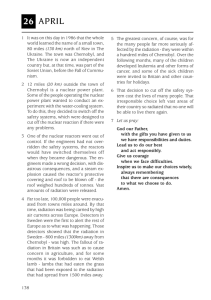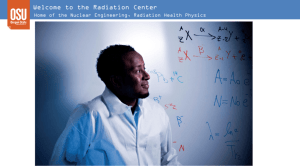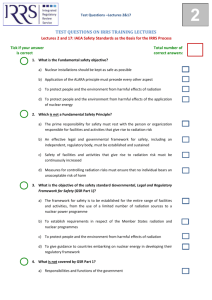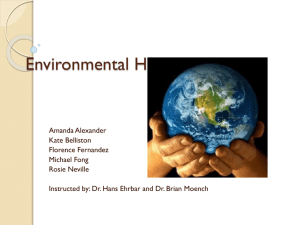charles_perrow_public_lecture_cbs
advertisement
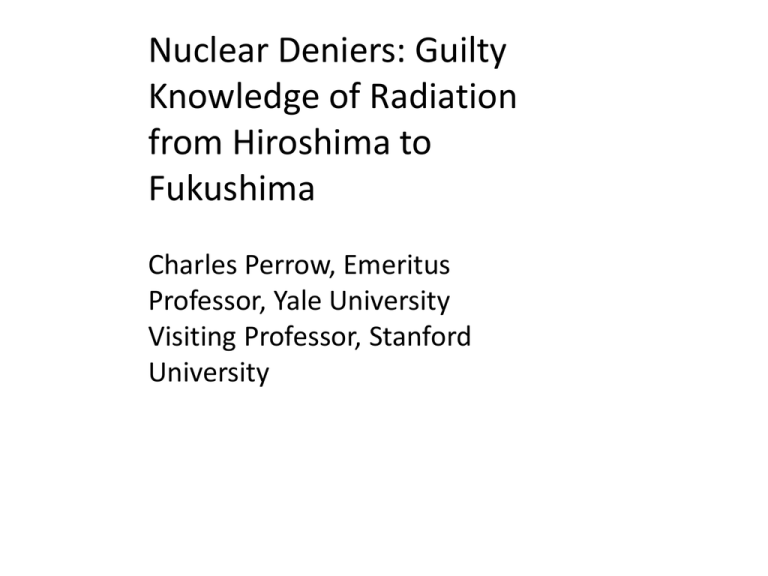
Nuclear Deniers: Guilty Knowledge of Radiation from Hiroshima to Fukushima Charles Perrow, Emeritus Professor, Yale University Visiting Professor, Stanford University radiation from • atomic bombs, • nuclear processing plants, and • nuclear power plants in several countries: Japan, the USA, the Soviet Union, the UK, Germany and France The bombing of Hiroshima and Nagasaki in 1945 “No Radioactivity in Hiroshima Ruin” “Survey Rules out Nagasaki Dangers” “Radioactivity after atomic bomb is only 1000th of that from luminous dial watch.” 1953: AEC: low-level exposure to radiation “can be continued indefinitely without any detectable bodily change.” 1954: H-bomb explosion in Marshall Islands; Residents and fishermen exposed “…they are more like us than the mice." 1956: Nat. Acad. of Scientists: Nuclear scientists: low-level radiation not harmful. Geneticists: all levels are harmful. 2005 BEIR VII: any dose harmful; extensive health effects other than cancer including genetic generational changes. Radiation-related excess deaths: 2,850 to 3,800 Bomb death rate from immediate effects: about 200,000 Nuclear bomb fuel processing plants 1957 Windscale, UK. Large areas of Wales contaminated. No announcement. Nuclear bomb fuel processing plants 1957 Chelyabinsk, Soviet Union, Ural Mountains. Nearly one half a million people irradiated. Secret for 30 years. Accepting nuclear 1953: US National Security Council: "The President and Secretary [John Foster] Dulles were in complete agreement that somehow or other the tabu [sic] which surrounds the use of atomic weapons would have to be destroyed.” “ While Secretary Dulles admitted that in the present state of world opinion we could not use an Abomb, we should make every effort now to dissipate this feeling." 1953 AEC Chair: “highlight the peaceful applications of nuclear explosive devices and thereby create a climate of world opinion that is more favorable to weapons development and tests.” As a DOD official put it in 1953: "The atomic bomb will be accepted far more readily if at the same time atomic energy is being used for constructive ends In 1953 the State Department warned that the civilian nuclear power industry could be seriously damaged because of the “mistaken impression” that low-level radiation is hazardous. 1959: International Atomic Energy Association (IAEA) and the World Health Organization (WHO) agree not to release radiation effects data the other has not agreed to. IAEA: to promote nuclear power, oversee its safety, and study the effects of radiation – conflicting mandates 1979: Three Mile Island, Harrisburg, PA Negligible radiation declared 1990 Columbia University: radiation too low to account for observed increases in cancer. Stress cited. 1997: University of California, Berkeley: “Accident doses were positively associated with cancer incidence. Associations were largest for leukemia, intermediate for lung cancer, and smallest for all cancers combined; larger for longer than for shorter latency; and larger with adjustment for socioeconomic variables.” 1987: Chernobyl, USSR Not announced for 2 days; late evacuation; no warnings on food; radiation sickness not allowed as diagnosis, etc. The radioactive cloud spread over Belarus, the Ukraine and parts of Russia, and then Europe. Chernobyl deaths: United Nations Scientific Committee on the Effects of Atomic Radiation (UNSCEAR): 64 (workforce only) UN Chernobyl Forum (UNSCEAR, IAEA, WHO) 4,000 deaths among the “liquidators.” Another report estimates an additional 5,000 deaths among the 6 million living in the contaminated areas of Ukraine, Belarus and Russia, giving us 9,000. Chernobyl deaths continued: Union of Concerned Scientists: 50,000 excess cancer cases and 25,000 excess deaths. Greenpeace: 200,000 Russia scientists: 950,000 premature cancer deaths IAEA: Not victims, but survivors. Calling them victims: “has led them to perceive themselves as helpless, weak and lacking control over their future. This, in turn, has led either to over cautious behavior and exaggerated health concerns, or to reckless conduct, such as consumption of mushrooms, berries and game from areas still designated as highly contaminated, overuse of alcohol and tobacco, and unprotected promiscuous sexual activity. we might ask how wise it is to build systems whose failure will prompt citizens in the affected area to engage in such destructive behavior. What if the plants behaved well? Children at highest risk. 2002 study of 8 US nuclear plants closed in 1987. Strontium 90 in milk drops sharply, as did birth defects and infant deaths. Biggest effect is childhood leukemia (CL) Germany, 2007 study found CL twice as likely near all 16 nuclear power plants. Could not determine cause. French 2012 study: similar results for 54 nuclear power plants. Cannot attribute to gaseous discharges. 2011: Fukushima’s rosy predictions: Nuclear Energy Institute declared two months after the accident, that ‘no health effects are expected among the Japanese people as a result of the events at Fukushima.’ The Fukushima Medical University in February, 2012, reported only about 29 people were expected to have doses over 10 millisieverts (mSv), and the highest recorded does was 23 mSv, well below the 100-mSv exposure level that might lead to a slight increase in cancer risk. Scientific American (republished in Nature): Those exposed, one expert said, “are probably getting better care than they were before” the accident. “Mental health is the most significant issue” said a professor of gerontology in Japan. "In terms of the health impact, the radiation is negligible," he said. "The radiation will cause very few, close to no deaths." (Prof. at Columbia University) "Much of the damage was really psychological—the stress of not knowing, of being relocated." (Berkeley professor) No point in making studies: Columbia U. radiologist: “40% of everybody will get cancer…It doesn’t seem to me that it’s possible to do an epidemiological study that will see an increased risk.” Head of US agency on protection and measurement: “There’s no opportunity for conducting epidemiological studies that have any chance of success.’’ “The doses are just too low,’’ he said. “If you were to do a proposal, it would not pass a scientific review.’’ British sociologist: The accident “actually represent a compelling case for [nuclear power] expansion, as even these old fashioned reactors have withstood the worse that nature could throw at them.” Unit 4 spent storage pool 100 feet up in a shaky, damaged building with high radioactivity, with as much Cesium 137 as at Chernobyl. US government grant to MIT to examine the "difficulties in gaining the broad social acceptance" of nuclear power. Some doubts: the external exposures over a 90 day period were between 20 -64 times the natural background radiation, or the equivalent of 300-950 chest ex-rays. The 70,000 people who spent a year in contaminated land outside of the evacuated area were exposed to an external radioactivity 100 times higher than normal background radiation in that first year. a rough estimate of a cancer rate of 2%, with 1,400 people expected to contract cancer due to the additional radiation from fallout during the year. a child living in one village and spending about 8 hours of the day outside and 16 hours inside would be exposed to about 148 mSv in the course of a year - 100 times the natural background radiation in Japan. This contradicts the WHO report of only 10-50 mSv. Over 35% of young people tested have thyroid cysts (a fluid-filled sac) or nodules (a solid tumor which could be carcinogenetic) according to a survey conducted in March of 2011 51% of the 527 children checked in after September, 2011, had internal exposures to cesium-137, and evidence of high-level exposure to gamma rays was detected Conclusions: Fukushima not much different • Atomic bomb and testing denials • Secrecy surrounding Windscale and Chernobyl. • Fallout from TMI more serious than allowed • Multiple denials about Chernobyl • Radiation from normal operation plants denied Vast investments at stake by weapons and power industries. Grant money to scientists for whitewashing Scientific ambiguity persists as “no harm in low-level radiation” is replaced by “too low to measure any harm.”

